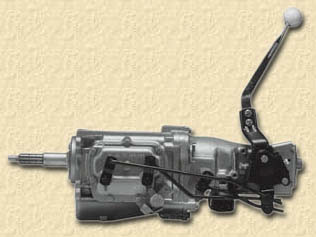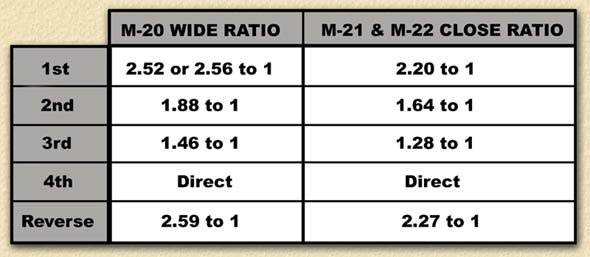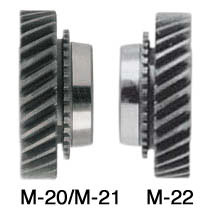|
|
| The Muncie 4-speed
transmission was used with many different GM models and engine
combinations from 1963 through 1974. The basic design and
operation theory of the gearbox changed little during this
period, however several design upgrades and modifications were
made during the total production run. The Muncie was used with
most performance engines, and is not to be confused with the
Saginaw or Borg Warner 4-speeds. |
 |
|
The Muncie is distinguished from the Saginaw in that
the reverse lever on the Muncie is mounted in the extension
housing, where the Saginaw reverse lever is mounted in the
side cover. The main difference between the Muncie and the
Borg-Warner is that the Muncie has a 7-bolt side cover and the
Borg Warner has a 9-bolt side
cover. | |
|
|

|
Muncie 4-speeds were produced in two different ratios
wide ratio (M-20) and close-ratio (M-21). An extra heavy duty
close-ratio version (M-22) was also offered on many of the
big-block high-performance models.The choice of transmission
was dictated by the engine size and rear-axle ratio. Axle
ratios of 3.73 and lower (numerically higher) came with
close-ratio transmissions, while axle ratios of 3.55 and
higher (numerically lower) used wide-ratio transmissions. In
addition, many GM high-performance engines came with M-22
“Rock-Crusher” in the 1970-73 years, however an early version
of the M-22 was available as early as 1965 in
Corvettes. |
Proper identification of the transmission type is
absolutely necessary, but sometimes difficult due to several
factors. First, GM used several different methods to label and
identify transmissions from year to year and model to model.
Unfortunately the identification systems seem to have many
exceptions, rendering them virtually useless to the restorer.
In addition, due to engine and transmission swaps, and
modifications that occur over the years many cars do not carry
the original drivetrain that they were produced
with.
For example, due to interchangeability, a 1969
Pontiac could have a trans case and gears from a Buick and a
rear housing (extension) from an Oldsmobile. Several
production changes through the years that effect the external
appearance may also cause additional confusion when
identifying a particular transmission:
1. Both
single and dual drain plugs were used.
2. Speedometer
adapters were used on either sides of the rear section
(extension).
3. Side covers were sometimes secured with
studs and nuts, other times with bolts.
4. Input shafts may
be fine or coarse spline. Output shafts may be large or small.
Combinations of these vary.
5. External shift levers are
secured with studs and nuts, others with bolts. Some levers
are long and some short.
6. Input shafts may have 1 ring, 2
rings, or no rings at
all. | |
|
M-22 “Rock Crusher”
Identification
The M-22
close-ratio transmission is easily identified internally from
the M-20 and M-21 versions by the angle of the gear
teeth.
The M-22 was only produced in a close-ratio
version, so it will not appear on models with high rear-axle
ratios (3.55 or lower numerically) unless someone has changed
it.
The main internal differences in the 3 types of
transmissions are listed in the parts below.
• M-20 differs
from M-21: Input shaft and Cluster gear
• M-20 & M-21
differ from M-22: Input shaft, Cluster gear, First, Second,
Third, Reverse idler gear
All other components
interchange, with the exception of production upgrades and
changes. For example, 1963-65 synchronizers, blocking rings,
etc. do not interchange with 1966 and newer versions, and
therefore the transmission must be stock or interchanged as a
unit.
|
M-20
Wide Ratio
Cluster gear
teeth: 25-22-19-17
Input shaft/gear teeth:
21
M-21
& M-22 Close-Ratio Cluster Gear teeth:
27-22-19-17
Input shaft/gear teeth: 26
 |
|
IMPORTANT |
If you have any questions, please contact
Year One. Call them
before ordering.
To ensure that you are ordering the correct parts for your
transmission, please carefully count the number of teeth on
all gears and or counter gears (clusters) to verify
transmission type. We recommend that all transmission parts be
ordered by telephone to verify requirements and reduce the
chance of ordering errors. We also recommend installation of
all parts by trained professionals with the proper tools and
equipment. If you are rebuilding your transmission yourself,
be sure to use a factory service manual.
| |
|
|
|
